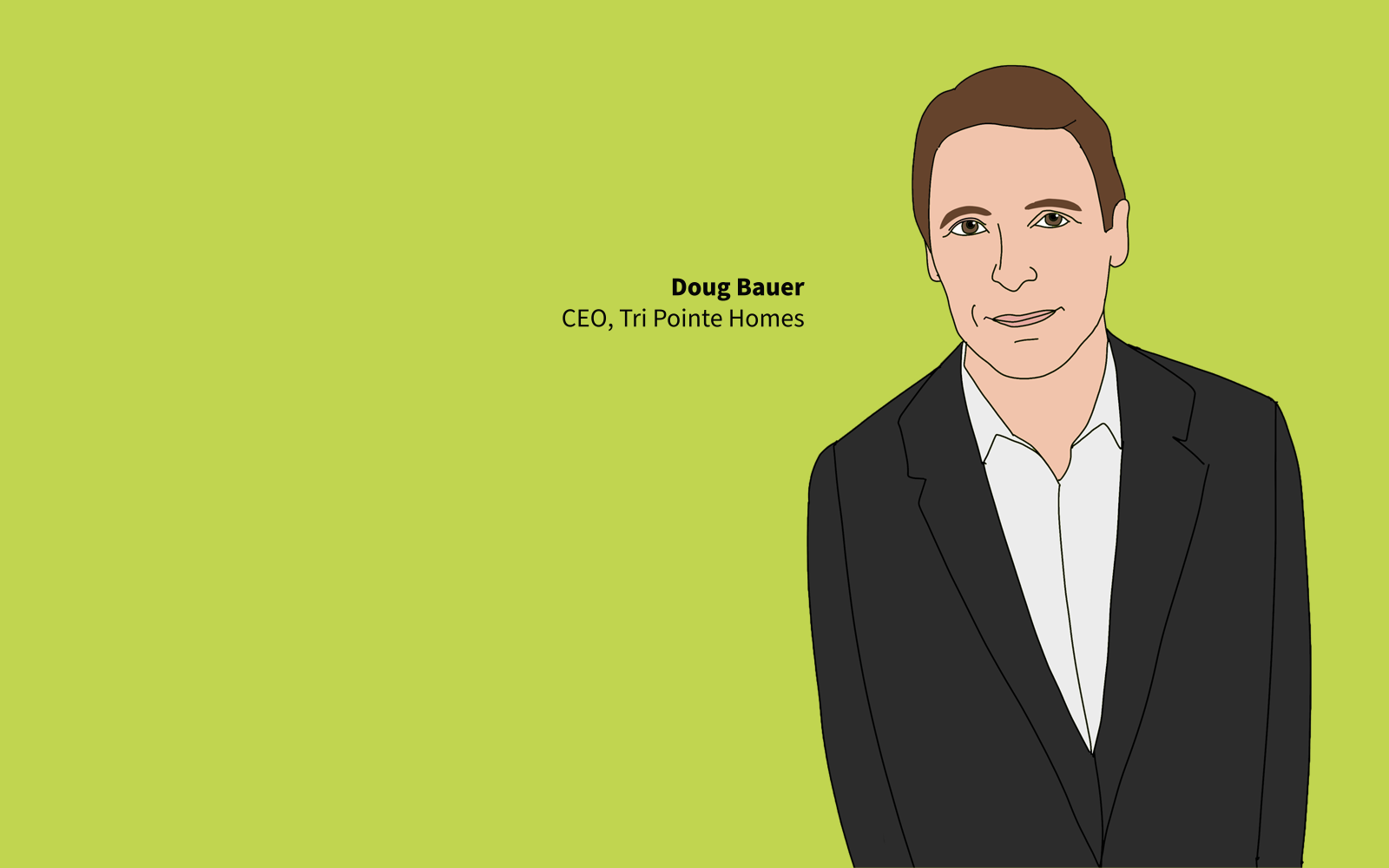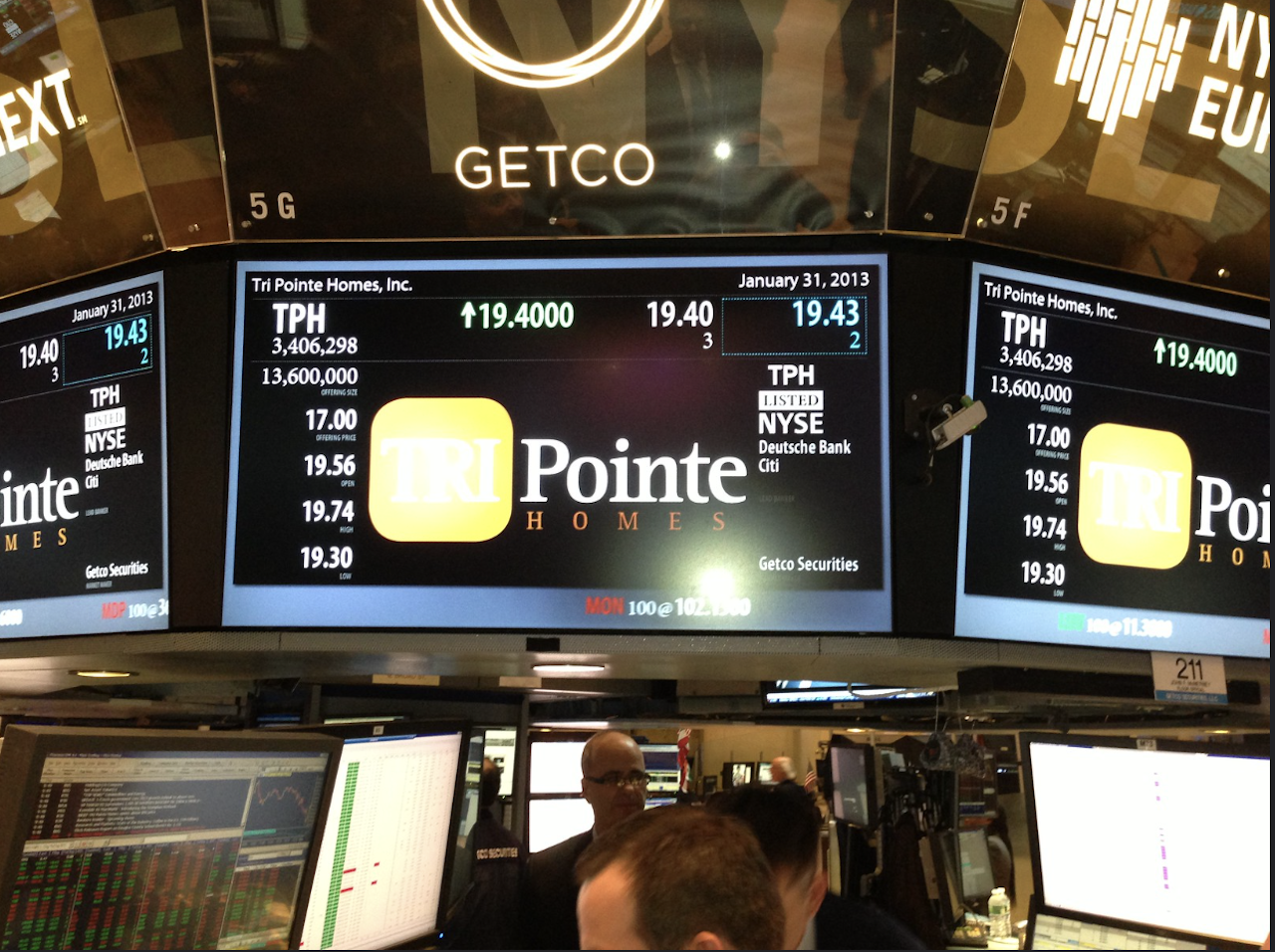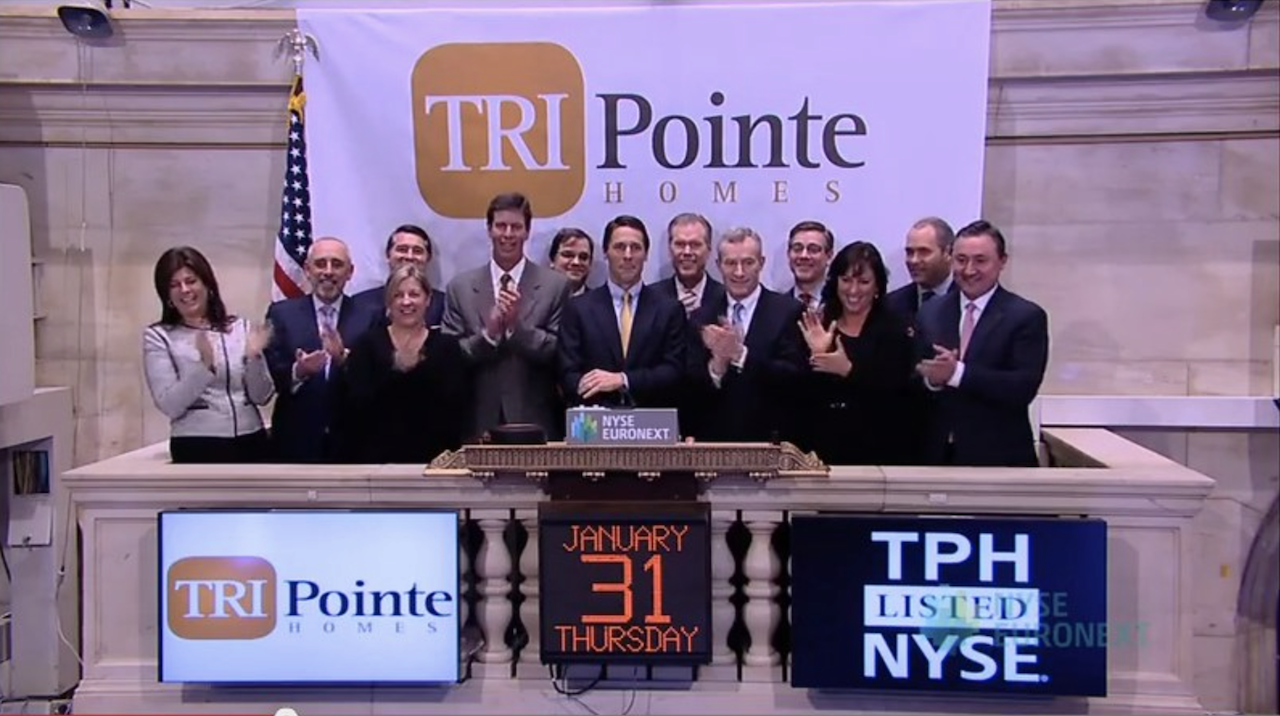Leadership
Ten Years After: Tri Pointe Marks A Milestone In Its Journey
A one-to-one chat with Tri Pointe CEO Doug Bauer as the organization he helped start during the Great Recession celebrates 10 years as a public homebuilding enterprise.

On January 31, 2013, Tri Pointe Homes became the first of nine homebuilding enterprises to go public that year.

Starwood Capital ceo Barry Sternlicht, who'd had a hand in that moment almost exactly a decade ago, had this to say to me.
Long term businesses are about management teams,” Sternlicht said of TRI Pointe CEO [Doug] Bauer, president and COO [Tom] Mitchell, and CFO [now retired, Mike] Grubbs. Sternlicht, chief executive of Starwood Capital, and arguably one of residential real estate’s five most powerful people, and who’d invested $150 million of Starwood money into 18-month-old TRI Pointe in September 2010, said, “We had a great team in place, one that could both tell our story, and, at the same time, not get distracted by the time and energy it takes to go public. It was important that they had been kicked in the butt a few times by then, which they had, and that’s good about their background.”

The story of the Bauer, Mitchell, Grubbs journey made for a homebuilding rollercoaster ride worth telling in three parts, here, here, and here.
In a statement, Tri Pointe marks the milestone:
Tri Pointe Homes® (NYSE: TPH), one of the largest homebuilders in the U.S., is proud to celebrate the 10-year anniversary of its IPO. At the time, the first builder to go public in nearly a decade, the company delivered 144 homes and generated $77.5 million of home sales revenue in 2012. In 2022, Tri Pointe Homes generated $4.3 billion in home sales revenue for the first time by delivering 6,063 homes across 10 states. The company achieved this milestone through proven leadership, an opportunistic acquisition strategy, and the design of innovative homes and communities reflecting its premium lifestyle brand positioning.
The company's genesis traced to kitchen table late nights and legal pads in the throes of The Great Financial Crash, which beset the entire economy along with all of residential real estate in 2007 and continued full bore through 2011. At this time, risks and opportunities were equally enormous.
The statement reads:
Tri Pointe Homes went public in 2013, just four years after its founding. A year later, in 2014, the company completed a $2.8 billion merger with Weyerhaeuser Real Estate Company (WRECO) in one of the largest deals in homebuilding industry history, giving Tri Pointe Homes a national footprint and transforming it into one of the largest homebuilders in the country. The transaction added five respected regional homebuilding brands to Tri Pointe Homes’ portfolio, each with deep ties to the communities they served, some for as long as a century. For six years following the merger, Tri Pointe Homes used the multiple brand approach it inherited from WRECO across the country.
We got to chat for a few moments last week with Tri Pointe CEO about some of the highlights, learnings, and ongoing vision for the enterprise, 10 years after. Here's Doug's responses to a selection of our questions:
Is Tri Pointe The One Its Founders Envisioned?
Doug Bauer:
A little history…in our premise when we started the company in 2009 was to start a new home builder unbundled from the Great Financial Crisis, with fresh perspective on product offerings while delivering premium brand experience for the customer. We thought then would be a perfect time for a fresh perspective. We originally envisioned ourselves to be a West Coast regional builder at the time coming out of that GFC.
One of the biggest strategic points that we learned over the years – and led to the commitment 10 years ago was to be a well-capitalized builder. It’s really important to be well-capitalized to withstand the economic cycles.
You fast-forward 10 years, and it sorts out like, we went from thought process of being regional West Coast builder to having an opportunity to acquire through a reverse merger Weyerhaeuser Real Estate Company in 2014. That combination allowed us to expand our strategic reach geographically. Allowed us to continue our focus on being a premium brand builder, but now throughout the country.
It allowed us to take our visioning that we started back in 2009 and expand it across the entire platform. That was fortuitous."
Anything You'd Do Differently?
Doug Bauer:
I never look back. I have no regrets… I love what we do. Our teams love what we do. I love the people that we work and the teams that we get to wake up every morning to work with. And most importantly, I love producing a home for families. We’re in the life changing business.. We change lives daily by building homes for families. There’s really nothing I would change, or any further advice I would give to myself or anybody else. I have a huge passion for the business.
Looking 10 Years Ahead, What Do You See?
Doug Bauer:
By 2033, I answer this in two parts. We definitely want our 15 existing divisions to have the right scale in each of their marketplaces. I define scale as being a top 10 builder by deliveries in each one of their markets, or revenues. We want to maintain that in each one of our 15 divisions organically. That’s our focus going forward over the next 10.
I also see, and we will also want to want to look for opportunistic growth opportunity, much like we did with Weyerhaeuser in 2014 . The company has the systems and key people and teams in place to be very opportunistic and integrate an opportunity, primarily to add scale to our business which will increase shareholder value. I’m a big believer that scale does matter.
Homebuilding 2033: More Similar Or Different?
Doug Bauer:
I feel that homebuilding, the actual construction process is not going to change dramatically over the next decade. That’s primarily because the US housing market is regulated at a very local level. It’s very hard to take technology, which has been attempted by a number of companies, and unfortunately a number of them have failed. They’ve aimed to simplify the construction process and make it much more efficient. And in order to do that you need to have a homogenous regulatory environment. Unfortunately, California’s different than Texas, and Texas is different than Arizona, and Arizona is different than DC, Virginia, and Maryland and so on and so forth.
However, I do forecast that the customer experience is something we will continue to improve on. Something that Linda Mamet, our Chief Marketing Officer, has been at the tip of the spear on. I do believe that by utilizing technology, we will improve the entire homebuying process from start to finish, Including the mortgage process. I don’t believe that’s going to go away in the U.S. either.
That’s my outlook, and in 10 years, I’ll be talking to you because I’ll be retired on some beach, too.
How Has Unifying The Six Brands Worked?
Doug Bauer:
One brand equals one team. It’s created a stronger national awareness. It has also brought six distinct brands that we had when we did the Weyerhaeuser deal in 2014 together more efficiently. And while utilizing technology as a single platform versus six, it has really made us much more efficient. That whole 'one-brand-one-team' program was executed flawlessly and I give Linda Mamet credit for making us one team. It’s really unified our team members…. Been a lot of fun, and It's brought a 1,300 or 1,400 team members across the country under one brand and under one team. Everybody’s embraced it despite the fact that there were some very strong local brands that Weyerhaeuser developed. I’d finish with brand – and Tri Pointe is no different – brand is is earned over time. By unifying us as one brand, we hope that over time the consumer, our teams, and Wall Street will recognize this unification over the years, just like the brand like Toll Brothers earned over 50 years after Bob Toll started it.
The unification of one brand was a very smart strategic move we made in 2021. Having one brand…. Has brought not only clarity to local market place but also the added clarity brings a certain amount of scale to it with our trades across the country for national and local sourcing, as well as with The Street.
What's Next In 2023?
Doug Bauer
I’ve been five or six different homebuilding cycles. They’re all different
The GFC had its own set of circumstances that drove housing to new levels. This cycle started In May of 2022. It’s going to have its own set of circumstances and outcomes. It’s much different and the fact that the Fed has in 2022, I believe it was seven very rapid increases in rates to combat inflation, which I think is the right thing to do. But it led to a quick and sudden cool down in the housing business. The consumer sat on the sidelines. It was shock and awe that that they performed. I don’t think Fed is done tightening the monetary policy.
Yes, we’ve seen some green shoots. But In the last week the mortgage rates went up 60 to 70 bps, from about 6% to about 6.8% or 6.9% on a conforming loan. Very interesting time. My personal feeling is Fed is not done tightening. There’ll be further price rediscovery. More product redesign that effectively make houses more affordable. We do need to make housing more affordable, whether it’s the GenXes, the Zs, the Millennials, the Baby Boom. We saw unprecedented housing price increases over two years due to this pandemic.
We’re adjusting quickly back to earth. The Fed has hit it hard…. Direct recipient of their tightening, which has definitely slowed down the housing business.
Many reports show housing starts down year over year mid-20% range. There’s still more adjustments. I don’t think we’re not in a trough yet. We’re not quite there.
But it’s all going to be different. One of the big differences you’re going to see in this cycle is home builders much stronger financials. Their balance sheets are much stronger with more land off balance sheet, greater liquidity levels. Our net debt to capital is 14.5%. All our peers have the same balance sheet strength. We also went into this cycle with very strong margins to absorb this price discovery process we’re going through. At the same time, we’re going to see some costs go down too, because starts go down 25%, the trades are going to be less busy and we’re already seeing that.
That’s my macro.
What makes you proud about Tri Pointe culture?
Doug Bauer
When you’re celebrating 10 years of being in this business, it clarifies the way our culture is very important. It’s important to any organization. It’s a key to having a successful team, key to hiring and retaining people, top talent. We take our culture very seriously.
I like to talk about two initiatives that are critical to our long term success over the next 10 years. Chief Human Resources Officer, Heather Hamilton Breidenthal, who’s become the culture ambassador for Tom [Mitchell, president and Chief Operating Officer] and one of the things we’re proud of are the initiatives we put in place to be recognized: 2022 recertification as one of the Great Places to Work, the 2022 Fortunes Best Places to work , including Millennials and Women, and In Construction. 2023 100 Best Places to Work. Those things are important to hiring retaining and building the culture here.
The other initiative is that Heather brought on Allison Baughman in late 2021. We hired her a Vice President of learning and development. I was a big fan of this because one of the things you do to try to retain people – whenever we hire a person, I say to them, ‘I want you to retire here at Tri Pointe. I want this to be your final resume job.’ What Ali has done has had an immediate big impact on learning and development. Her first initiative that was outstanding of Leadership Development Program of some high potential leaders at University of Wisconsin last year.
I’m very proud of the initiative, but all the kudos go to Ali.
MORE IN Leadership
Homebuilders Face The Long “Muddle-Through” Economy
Moody’s Analytics Deputy Chief Economist Cristian deRitis kicked off Focus On Excellence in Denver with a clear-eyed view of a cooling—but not collapsing—economy. His message for homebuilding leaders: plan for a grind, not a rebound, as 2026–2030 take shape.
How Homebuilding Sales Became A Strategic Center Of Gravity
Dave Rice and New Home Star help turn homebuilder sales associates into data-powered business strategists and a linchpin to critical customer feedback. Here’s why that matters now more than ever.
Century Communities Keeps Control, Delivers In A Tough Quarter
Q3 performance spotlights cost control, strategic pricing, and buyer-first execution as Century Communities sets foundation for sustainable growth into 2026.
